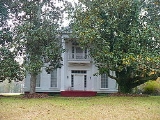
William Poole House
Encyclopedia
The William Poole House, also known as the William Cade Thompson House, is a historic plantation
house and historic district
in Dayton
, Alabama
. The Greek Revival
style house was completed in 1848. It and the surrounding grounds were added to the National Register of Historic Places
on July 7, 1994 as a part of the Plantation Houses of the Alabama Canebrake and Their Associated Outbuildings Multiple Property Submission.
Plantation
A plantation is a long artificially established forest, farm or estate, where crops are grown for sale, often in distant markets rather than for local on-site consumption...
house and historic district
Historic district (United States)
In the United States, a historic district is a group of buildings, properties, or sites that have been designated by one of several entities on different levels as historically or architecturally significant. Buildings, structures, objects and sites within a historic district are normally divided...
in Dayton
Dayton, Alabama
Dayton is a town in Marengo County, Alabama, United States. The population was 60 at the 2000 census.-History:Dayton began to be settled in the early 19th century, with a town survey done and a "public well" established in 1832. The post office was established in 1837. It was incorporated on...
, Alabama
Alabama
Alabama is a state located in the southeastern region of the United States. It is bordered by Tennessee to the north, Georgia to the east, Florida and the Gulf of Mexico to the south, and Mississippi to the west. Alabama ranks 30th in total land area and ranks second in the size of its inland...
. The Greek Revival
Greek Revival architecture
The Greek Revival was an architectural movement of the late 18th and early 19th centuries, predominantly in Northern Europe and the United States. A product of Hellenism, it may be looked upon as the last phase in the development of Neoclassical architecture...
style house was completed in 1848. It and the surrounding grounds were added to the National Register of Historic Places
National Register of Historic Places
The National Register of Historic Places is the United States government's official list of districts, sites, buildings, structures, and objects deemed worthy of preservation...
on July 7, 1994 as a part of the Plantation Houses of the Alabama Canebrake and Their Associated Outbuildings Multiple Property Submission.

